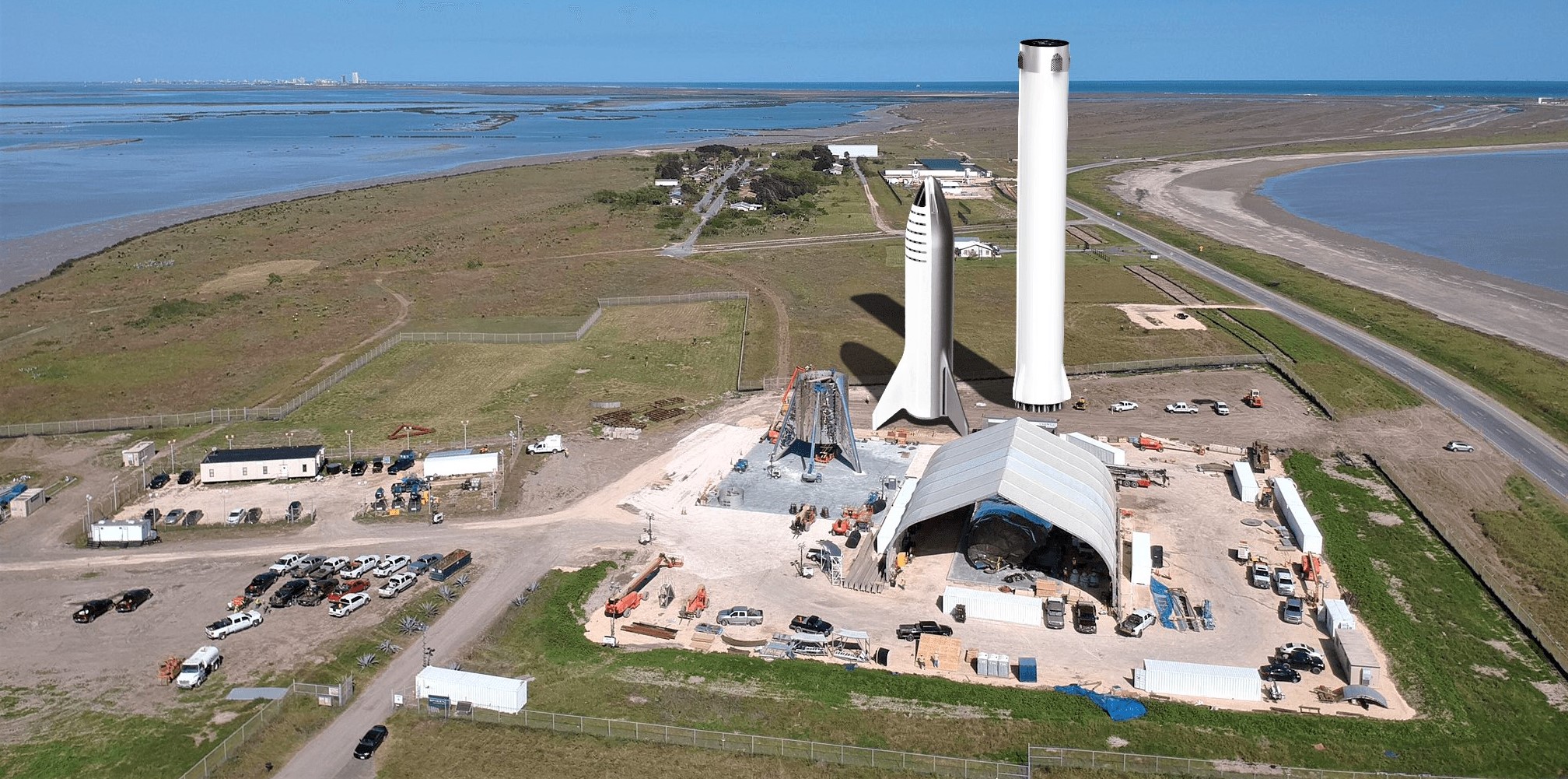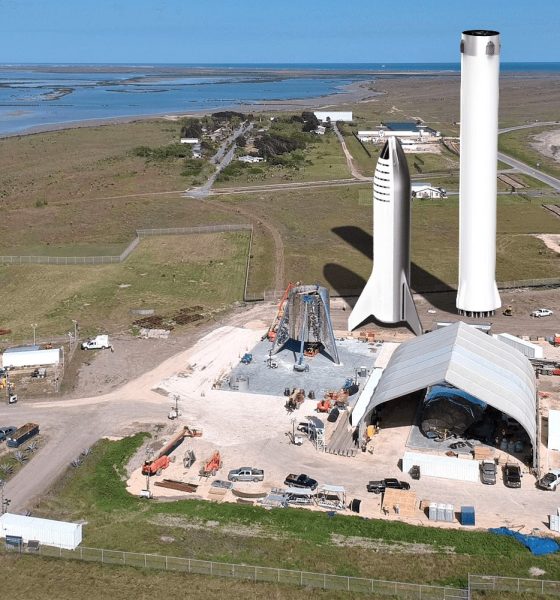

SpaceX
SpaceX will build and launch Starship/Super Heavy in Texas and Florida, says Musk
According to SpaceX CEO Elon Musk, the company has plans to both build and launch BFR’s Starship upper stages and Super Heavy boosters at facilities located in Boca Chica, Texas and Cape Canaveral, Florida.
Indicative of SpaceX and Musk’s rapidly evolving plans for the next-generation, ultra-reusable launch system, the to stainless steel over carbon composites appears to continue to have a range of trickle-down consequences (or benefits) throughout the rocket’s design, production, launch, and operations. Given the 3+ radical, clean-sheet design changes the BFR program has undergone in about as many years, it’s hard to definitively conclude much about the latest iteration. Nevertheless, Musk’s indication that stainless steel BFRs may now be built simultaneously at multiple locations suggests that the construction of steel Starships and Super Heavies could be radically easier (and cheaper) than their composite predecessors.
Over the last several months, SpaceX’s manufacturing plans for the massive Starship and Super Heavy vehicles have effectively been up in the air from a public perspective. Official statements provided in January suggested that the first prototypes would be built in-situ after word broke that SpaceX had prematurely terminated a lease with the Port of Los Angeles, where the company had – throughout 2018 – been planning to construct a dedicated seaside BFR factory.
Likely for a variety of reasons, all of which are unknown, SpaceX apparently no longer has a pressing need for dedicated traditional manufacturing facilities at this point in time. Instead, the company is relying extensively on the largely unprecedented practice of building its first suborbital and orbital Starship and Super Heavy vehicles outdoors, much to the visible discomfort of aerospace industry practitioners, followers, and fans alike.
At a bare minimum, SpaceX’s decision to fabricate and assemble large-scale methalox rocket stages with quite literally zero protection from the elements may be one of the most ‘nontraditional’ things the habitually disruptive company has ever done. At the opposite end of the spectrum, building rockets outside could be perceived as an unfathomably foolish endeavor, radically increasing the risk of dangerous manufacturing defects, foreign objects debris (FOD) mitigation, and – ultimately – major vehicle failures. From such an external perspective, wholly lacking any insight from SpaceX itself, it’s difficult to conclude much of anything.
On the one hand, a highly-disciplined adherence to the tenets of best aerospace industry practices and responsible engineering could probably mitigate the risks of en 

Given that the production of orbital-class, super-heavy lift rockets has really only been attempted twice (Saturn V and Russia’s N1), both times with custom-built, environmentally-controlled factories, it’s likely that SpaceX is already suffering from the inherent uncertainty of the tasks at hand; forging new ground – especially in highly technical fields – is rarely easy or forgiving. Given the aforementioned challenges of building large and reliable rockets at all, challenges that regularly topple vehicles built in traditional factories, it will likely remain an open question if SpaceX can consistently build reliable, technologically-advanced rockets and spacecraft outside until those vehicles have quite literally proven themselves in orbit.
Toot Toot! Hopper is chomping at the bit today!
?@BocaChicaGal https://t.co/0ZEXcKOWwH pic.twitter.com/PEm7c12KTi— Chris B – NSF (@NASASpaceflight) March 18, 2019
Difficulties aside, it’s easy to understand why SpaceX (or maybe just Elon) is willing to at least attempt something that has never been done before. If the company could find a way to reliably build complex, high-performance rockets without the need for expensive factories, it could radically change the paradigm of rocketry by reducing the often eye-watering upfront costs of building giant launch vehicles. The ability to build rockets almost independently of dedicated factories or assembly facilities would also allow SpaceX to – as Musk said – build their vehicles where they launch, further minimizing the significant challenges and costs of transporting extremely large structures more than a couple of miles.
Regardless of the major challenges standing between SpaceX and its stainless steel Starship/Super Heavy aspirations, Elon Musk appears to be as confident as ever, frankly stating that Starship’s rate of progress “far exceeds” that of Falcon and Dragon. In other words, the apparent instability of the BFR program may actually end up being to its benefit, potentially resulting in a finished product that simultaneously takes less time to come to fruition and is ultimately much closer to its original design intent. At risk of putting the wrong words into Musk’s mouth, it seems that he believes that SpaceX might be able to arrive at a Starship/Super Heavy combo much closer to Falcon 9 Block 5 than Falcon 9 V1.0 and do so far sooner than most believe is possible.
Only time will tell. In the meantime, there will be plenty of fireworks, beginning as early as this week with the first static fire test – and potential hops – of SpaceX’s massive Starship Hopper. Stay tuned for updates!
Check out Teslarati’s Marketplace! We offer Tesla accessories, including for the Tesla Cybertruck and Tesla Model 3.

Elon Musk
Starlink achieves major milestones in 2025 progress report
Starlink wrapped up 2025 with impressive growth, adding more than 4.6 million new active customers and expanding service to 35 additional countries, territories, and markets.

Starlink wrapped up 2025 with impressive growth, adding more than 4.6 million new active customers and expanding service to 35 additional countries, territories, and markets. The company also completed deployment of its first-generation Direct to Cell constellation, launching over 650 satellites in just 18 months to enable cellular connectivity.
SpaceX highlighted Starlink’s impressive 2025 progress in an extensive report.
Key achievements from Starlink’s 2025 Progress
Starlink connected over 4.6 million new customers with high-speed internet while bringing service to 35 more regions worldwide in 2025. Starlink is now connecting 9.2 million people worldwide. The service achieved this just weeks after hitting its 8 million customer milestone.
Starlink is now available in 155 markets, including areas that are unreachable by traditional ISPs. As per SpaceX, Starlink has also provided over 21 million airline passengers and 20 million cruise passengers with reliable high-speed internet connectivity during their travels.
Starlink Direct to Cell
Starlink’s Direct to Cell constellation, more than 650 satellites strong, has already connected over 12 million people at least once, marking a breakthrough in global mobile coverage.
Starlink Direct to Cell is currently rolled out to 22 countries and 6 continents, with over 6 million monthly customers. Starlink Direct to Cell also has 27 MNO partners to date.
“This year, SpaceX completed deployment of the first generation of the Starlink Direct to Cell constellation, with more than 650 satellites launched to low-Earth orbit in just 18 months. Starlink Direct to Cell has connected more than 12 million people, and counting, at least once, providing life-saving connectivity when people need it most,” SpaceX wrote.
Elon Musk
Starlink passes 9 million active customers just weeks after hitting 8 million
The milestone highlights the accelerating growth of Starlink, which has now been adding over 20,000 new users per day.

SpaceX’s Starlink satellite internet service has continued its rapid global expansion, surpassing 9 million active customers just weeks after crossing the 8 million mark.
The milestone highlights the accelerating growth of Starlink, which has now been adding over 20,000 new users per day.
9 million customers
In a post on X, SpaceX stated that Starlink now serves over 9 million active users across 155 countries, territories, and markets. The company reached 8 million customers in early November, meaning it added roughly 1 million subscribers in under seven weeks, or about 21,275 new users on average per day.
“Starlink is connecting more than 9M active customers with high-speed internet across 155 countries, territories, and many other markets,” Starlink wrote in a post on its official X account. SpaceX President Gwynne Shotwell also celebrated the milestone on X. “A huge thank you to all of our customers and congrats to the Starlink team for such an incredible product,” she wrote.
That growth rate reflects both rising demand for broadband in underserved regions and Starlink’s expanding satellite constellation, which now includes more than 9,000 low-Earth-orbit satellites designed to deliver high-speed, low-latency internet worldwide.
Starlink’s momentum
Starlink’s momentum has been building up. SpaceX reported 4.6 million Starlink customers in December 2024, followed by 7 million by August 2025, and 8 million customers in November. Independent data also suggests Starlink usage is rising sharply, with Cloudflare reporting that global web traffic from Starlink users more than doubled in 2025, as noted in an Insider report.
Starlink’s momentum is increasingly tied to SpaceX’s broader financial outlook. Elon Musk has said the satellite network is “by far” the company’s largest revenue driver, and reports suggest SpaceX may be positioning itself for an initial public offering as soon as next year, with valuations estimated as high as $1.5 trillion. Musk has also suggested in the past that Starlink could have its own IPO in the future.
News
SpaceX shades airline for seeking contract with Amazon’s Starlink rival

SpaceX employees, including its CEO Elon Musk, shaded American Airlines on social media this past weekend due to the company’s reported talks with Amazon’s Starlink rival, Leo.
Starlink has been adopted by several airlines, including United Airlines, Qatar Airways, Hawaiian Airlines, WestJet, Air France, airBaltic, and others. It has gained notoriety as an extremely solid, dependable, and reliable option for airline travel, as traditional options frequently cause users to lose connection to the internet.
Many airlines have made the switch, while others continue to mull the options available to them. American Airlines is one of them.
A report from Bloomberg indicates the airline is thinking of going with a Starlink rival owned by Amazon, called Leo. It was previously referred to as Project Kuiper.
American CEO Robert Isom said (via Bloomberg):
“While there’s Starlink, there are other low-Earth-orbit satellite opportunities that we can look at. We’re making sure that American is going to have what our customers need.”
Isom also said American has been in touch with Amazon about installing Leo on its aircraft, but he would not reveal the status of any discussions with the company.
The report caught the attention of Michael Nicolls, the Vice President of Starlink Engineering at SpaceX, who said:
“Only fly on airlines with good connectivity… and only one source of good connectivity at the moment…”
CEO Elon Musk replied to Nicolls by stating that American Airlines risks losing “a lot of customers if their connectivity solution fails.”
American Airlines will lose a lot of customers if their connectivity solution fails
— Elon Musk (@elonmusk) December 14, 2025
There are over 8,000 Starlink satellites in orbit currently, offering internet coverage in over 150 countries and territories globally. SpaceX expands its array of satellites nearly every week with launches from California and Florida, aiming to offer internet access to everyone across the globe.
Currently, the company is focusing on expanding into new markets, such as Africa and Asia.








